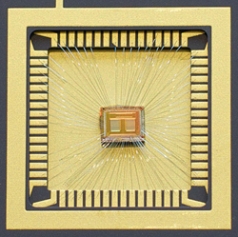One of the more promising solid state memory technologies on the horizon is Phase Change Memory (PCM). PCM has the potential to write data faster than current DRAM chips by charging atoms within a crystal. This has led some people to believe that the technology might enable the much-sought-after instantaneous computer boot-up. Ars Technica discussed the future prospects for PCM last week.
 At the atomic level, PCM stores data in a compound of germanium, antimony and tellurium. When a voltage is applied to the atoms, they change into an ordered crystal. The data can then be deleted by melting the crystalline substance. To read the information, a computer determines the electrical resistance of the material.
At the atomic level, PCM stores data in a compound of germanium, antimony and tellurium. When a voltage is applied to the atoms, they change into an ordered crystal. The data can then be deleted by melting the crystalline substance. To read the information, a computer determines the electrical resistance of the material.
An important attribute of phase change memory is that the technology is non-volatile. This means it does not require power to retain information like standard RAM offerings. Along with the possibility of replacing system memory, these chips might end up competing with NAND flash as well.
Some memory manufacturers are dabbling with PCM on a small scale. Micron offers phase change modules with densities up to 128 MB and Samsung inserted PCM into an unnamed cell phone, but ended up removing it later on.
Despite the benefits, PCM suffers from an inherent issue that has slowed its path to adoption. The biggest one is its write speed. Current DRAM technology can perform write operations within a 1-10 nanosecond window, which is faster than the time it takes for the germanium, antimony and tellurium compound in PCM to crystallize. Other crystalline compounds with faster reaction times have been researched, but they are not as stable as the current PCM design, slowly erasing themselves in low temperatures over time.
Recent research from the University of Cambridge has given hope to the new technology though. Stephen Elliott, Professor of Chemical Physics at the university, along with his colleagues, have discovered a method to improve PCM write speed.
By preparing the material with a 0.3-volt electrical current, crystallization occurred after receiving a 500-picosecond burst of 1 volt. Essentially, the low current made the material act like water at near-freezing temperatures. A few crystalline seeds formed, enabling the material to change at an accelerated rate when receiving additional voltage. The improvement was ten times faster than similar compounds that were tested and remained stable for 10,000 write-rewrite cycles.
The need for extra electrical current during the write cycle could become an Achilles heel for phase change memory, however, since that’s going to increase the overall power draw. It’s a relatively new development though, and further optimizations may be under development. If the price point and power consumption are competitive, PCM may indeed replace one or more current memory technologies.


























































